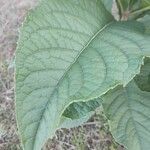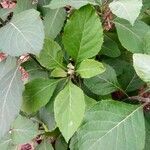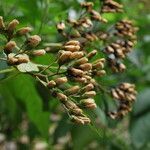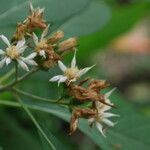Shrub or small tree, up to 8 m tall; stem striate, sparsely to densely felted and gland-dotted, eglandular trichomes T-shaped and medifixed. Leaves alternate, subsessile to petiolate, narrowly ovate to lanceolate or elliptic, (20-)90-170 x 35-60 mm, apex acute to sub-acuminate, base cuneate, margins sub-entire to serrulate-crispulate, upper surface puberulous to glabrescent, greyish green, under surface pubescent or crisped-tomentose and paler, eglandular trichomes short-spurred with cap-cell attached subbasally; petiole 0.5-10.0 mm long. Capitula in terminal corymbs, 5-flowered, flowers sweetly scented. Involucre globose-campanulate, 3-5 mm diam. when pressed; bracts in ±5 series, imbricate, sparsely hairy to glabrous and gland-dotted near apices, sometimes sharply keeled, especially distally, margins ciliate, green with darker median streak near tip, outer bracts ovate-elliptic, 0.5-1.0 mm long, median bracts oblong-elliptic, 2.0-5.0 x 1.5 mm, obtuse, inner bracts narrowly oblong-oblanceolate, 2.0-5.0 x 1.5 mm, obtuse to acute, caducous. Florets white, creamy-white, pale pinkish or pale mauve, corolla, 6-9 mm long, gland-dotted, tube narrowly funnel-shaped, lobes linear-lanceolate, 3-5 mm long. Anthers sagittate with triangular apical appendages. Style up to 5 mm long, pilose distally and on branches, branches 2.5-3.0 mm long. Cypselas narrowly turbinate to subcylindric, ±10-ribbed, 2.0-3.5 mm long, setulose on ribs and gland-dotted, especially between ribs; pappus biseriate, outer scales linear, barbellate, 1-3 mm long, caducous, inner bristles barbellate, 4-6 mm long, cream-coloured to pale tawny.
More
Small tree or shrub, up to 3 m high. Leaves somewhat elliptic, tapering ± equally to apex and base, margins flat. Involucre wider than long. Pappus long-exserted from involucre, outer pappus of caducous scale-like setae, inner bristles scabrid, subequal. Heads with 10 or more flowers. Achenes setulose, glandular. Flowers white or pale mauve.
A herb. Possibly Vernonia amygdalina. Naming confused.
Along rivers and lakes, in forest margins, woodland and grassland, at elevations up to 2,000 metres. Often found in disturbed localities such as abandoned farmland and in secondary woodland.




